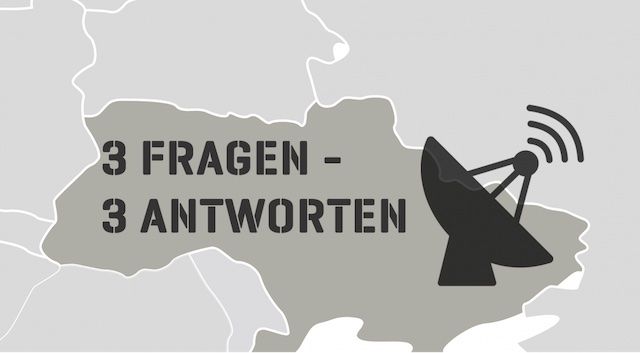Hol Dir den wöchentlichen SPARTANAT-Newsletter.
Dein Bonus: das gratis E-Book von SPARTANAT.

UKRAINE: 3 FRAGEN – 3 ANTWORTEN, TEIL 25: Elektronischer Kampf?
Hauptmann Rudolf Reinprecht ist Gruppenkommandant und Ausbildungsleiter für Elektronische Kriegsführung am Institut "Cyber und Elektronische Kriegsführung" der Führungsunterstützungsschule. Er beantwortet Fragen zu den Themen Kommunikation und Signals Intelligence.
Hauptmann Rudolf Reinprecht ist Lehrgruppenkommandant und Hauptlehroffizier für Elektronische Kampfführung am Institut „Cyber und Elektronische Kampfführung“ der Führungsunterstützungsschule. Hier beantwortet er Fragen zu den Themen Kommunikation und Fernmeldeaufklärung.

Das sagt der Bundesheer Experte:
Wie funktioniert das Abhören des gegnerischen Funkverkehrs bzw. der gegnerischen Kommunikation überhaupt? Welche Gegenmaßnahmen können getroffen werden?
Das Abhören oder Analysieren der Kommunikation besteht grundlegend aus zwei Tätigkeiten – der Auswertung des Signals selbst und der Inhaltsauswertung. Bei der Signalauswertung können Parameter wie der Standort und Gerätetyp des Senders (Ortung), hierarchische Führungsstrukturen (Verkehrsbeziehungen) und Verhalten des Gegners erkannt werden. Durch die Inhaltsauswertung können die Pläne oder auch Schwachstellen des Gegners erkannt werden, dies ist allerdings erschwert durch Sprachbarrieren oder moderne Verschlüsselungen.
Es gibt eine Vielzahl an Möglichkeiten zur Erschwerung der eigenen Aufklärung, welche sich in drei Kategorien gliedern, die technischen Schutzmaßnahmen (Verschlüsselung, moderne Übertragungsarten), die betrieblichen Schutzmaßnahmen (alle Tätigkeiten des ausgebildeten Bedienpersonals) und die taktischen Schutzmaßnahmen (Funkstille).
Bis auf welche Entfernungen kann man mit Fernmeldeaufklärung den Gegner abhören? Können die Sendeanlagen geortet werden?
Die Aufklärungsentfernungen sind abhängig von einer Vielzahl an Faktoren, wie zum Beispiel der Leistung des Senders und der verwendeten Frequenz oder der Geografie.
Grundsätzlich kann gesagt werden, dass Kurzwellenkommunikation (HF) potentiell weltweit abhörbar ist, hingegen Ultrakurzwellenkommunikation bis zu einer Tiefe von 50 bis 100 Kilometern (Leistung und Geografie) detektierbar ist. Jeder Sender, der ein Signal emittiert, ist auch ortbar. Unterschiede gibt es allerdings bei der Reichweite und Genauigkeit der Ortung.
Welche Möglichkeiten der Fernmeldeaufklärung besitzt Österreich?
Die Fernmeldeaufklärung und ihre Einsatzgebiete unterscheiden sich durch die Ebenen, denen sie unterstellt sind, in strategische, operative und taktische Aufklärung. Im Bereich der taktischen Aufklärung ist Österreich im Aufbau einer gesamtheitlichen Kompetenz zur Unterstützung eingesetzter Truppen, um dem taktischen Kommandanten vor Ort ein genaues und aktuelles Lagebild über potentielle Konfliktparteien zu liefern und so den Schutz der eigenen Kräfte zu erhöhen.
BUNDESHEER im Internet
UKRAINE: 3 Fragen – 3 Antworten
– UKRAINE: 3 FRAGEN – 3 ANTWORTEN, TEIL 24: TAKTISCHE ATOMWAFFEN?
– UKRAINE: 3 FRAGEN – 3 ANTWORTEN, TEIL 23: MARIUPOL?
– UKRAINE: 3 FRAGEN – 3 ANTWORTEN, TEIL 22: PHOSPHORBOMBEN?
– UKRAINE: 3 FRAGEN – 3 ANTWORTEN, TEIL 21: KRIEG UND RECHT?
– UKRAINE: 3 FRAGEN – 3 ANTWORTEN, TEIL 20: BIOLOGISCHE WAFFEN?
– UKRAINE: 3 FRAGEN – 3 ANTWORTEN, TEIL 19: ABC-GEFAHREN?
– UKRAINE: 3 FRAGEN – 3 ANTWORTEN, TEIL 18: NACHSCHUB?
– UKRAINE: 3 FRAGEN – 3 ANTWORTEN, TEIL 17: RAKETEN UND FLUGABWEHR?
– UKRAINE: 3 FRAGEN – 3 ANTWORTEN, TEIL 16: LUFTKAMPF?
– UKRAINE: 3 FRAGEN – 3 ANTWORTEN, TEIL 15: KAMPF DER VERBUNDENEN WAFFEN?
– UKRAINE: 3 FRAGEN – 3 ANTWORTEN, TEIL 14: PANZERKAMPF?
– UKRAINE: 3 FRAGEN – 3 ANTWORTEN, TEIL 13: KAMPF UNTER DER ERDE?
– UKRAINE: 3 FRAGEN – 3 ANTWORTEN, TEIL 12: CYBERWAR?
– UKRAINE: 3 FRAGEN – 3 ANTWORTEN, TEIL 11: NEUTRALITÄT?
– UKRAINE: 3 FRAGEN – 3 ANTWORTEN, TEIL 10: WIE LÄUFTS?
– UKRAINE: 3 FRAGEN – 3 ANTWORTEN, TEIL 9: ABC GEFAHR?
– UKRAINE: 3 FRAGEN – 3 ANTWORTEN, TEIL 8: KAMPF UM DIE STÄDTE
– UKRAINE: 3 FRAGEN – 3 ANTWORTEN, TEIL 7: LUFTKRIEG UND DROHNEN
– UKRAINE: 3 FRAGEN – 3 ANTWORTEN, TEIL 6: ATOMKRAFTWERKE UND NUKLEARE BEDROHUNG
– UKRAINE: 3 FRAGEN – 3 ANTWORTEN, TEIL 5: WELCHE WAFFEN?
– UKRAINE: 3 FRAGEN – 3 ANTWORTEN, TEIL 4: WAFFEN FÜR KIEW?
– UKRAINE: 3 FRAGEN – 3 ANTWORTEN, TEIL 3: GIBT ES WIDERSTAND?
– UKRAINE: 3 FRAGEN – 3 ANTWORTEN, TEIL 2: WELCHE FOLGEN HAT DER ANGRIFF?
SPARTANAT ist das Online-Magazin für Military News, Tactical Life, Gear & Reviews.
Schickt uns eure News: [email protected]
Werbung
Hol Dir den wöchentlichen SPARTANAT-Newsletter.
Dein Bonus: das gratis E-Book von SPARTANAT.


